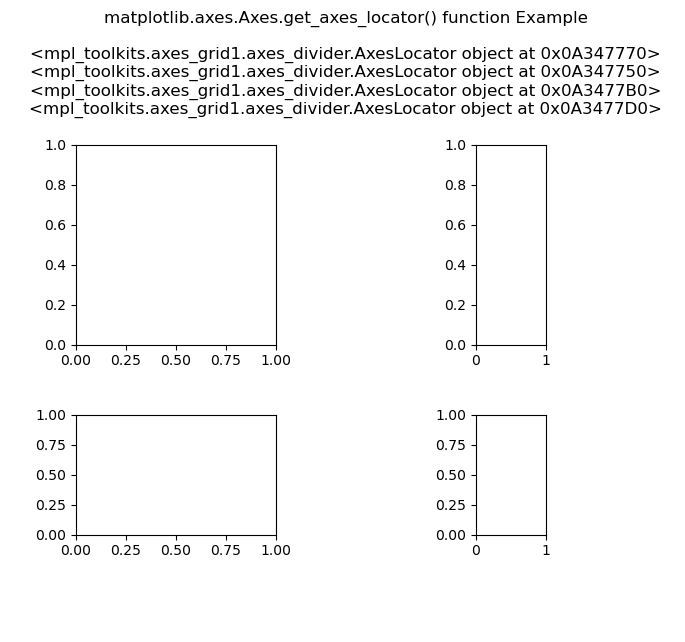Matplotlib是Python中的一个库,它是数字的-NumPy库的数学扩展。轴类包含大多数图形元素:Axis,Tick,Line2D,Text,Polygon等,并设置坐标系。 Axes实例通过callbacks属性支持回调。
matplotlib.axes.Axes.get_axes_locator()函数
matplotlib库的axiss模块中的Axes.set_axes_locator()函数用于获取轴定位器。
用法: Axes.get_axes_locator(self)
返回值:此方法返回axes_locator。
以下示例说明了matplotlib.axes中的matplotlib.axes.Axes.get_axes_locator()函数:
范例1:
# Implementation of matplotlib function
from mpl_toolkits.axes_grid1 import Size, Divider
import matplotlib.pyplot as plt
fig = plt.figure(1, (6, 6))
value1 = [Size.Fixed(2.),
Size.Fixed(.8),
Size.Fixed(1.2),
Size.Fixed(.7)]
value2 = [Size.Fixed(1.2),
Size.Fixed(.7),
Size.Fixed(2.)]
polygon = (0.2, 0.2, 0.4, 0.4)
resultant = Divider(fig, polygon,
value1, value2,
aspect = False)
ax1 = fig.add_axes(polygon, label ="2")
ax2 = fig.add_axes(polygon, label ="3")
ax3 = fig.add_axes(polygon, label ="1")
ax4 = fig.add_axes(polygon, label ="4")
ax1.set_axes_locator(resultant.new_locator(nx = 0,
ny = 0))
ax2.set_axes_locator(resultant.new_locator(nx = 0,
ny = 2))
ax3.set_axes_locator(resultant.new_locator(nx = 3,
ny = 2))
ax4.set_axes_locator(resultant.new_locator(nx = 3,
nx1 = 4,
ny = 0))
w = ax1.get_axes_locator()
w2 = ax2.get_axes_locator()
w3 = ax3.get_axes_locator()
w4 = ax4.get_axes_locator()
fig.suptitle('matplotlib.axes.Axes.get_axes_locator()\
function Example\n\n'
+str(w)+'\n'+str(w2)+'\n'+str(w3)+'\n'+str(w4)+'\n\n\n\n')
plt.show()输出:

范例2:
# Implementation of matplotlib function
import numpy as np
import matplotlib.pyplot as plt
from mpl_toolkits.axes_grid1.axes_divider import HBoxDivider
import mpl_toolkits.axes_grid1.axes_size as Size
arr1 = np.arange(40).reshape((8, 5))
arr2 = np.arange(12).reshape((3, 4))
fig, (ax1, ax2) = plt.subplots(1, 2)
ax1.imshow(arr1)
ax2.imshow(arr2)
rect = 111
pad = 1
for ax in [ax1, ax2]:
ax.locator_params(nbins = 1)
ax.xaxis.set_visible(False)
ax.yaxis.set_visible(False)
h1, v1 = Size.AxesX(ax1), Size.AxesY(ax1)
h2, v2 = Size.AxesX(ax2), Size.AxesY(ax2)
pad_v = Size.Scaled(1)
pad_h = Size.Fixed(pad)
my_divider = HBoxDivider(fig, rect,
horizontal =[h1, pad_h, h2],
vertical =[v1, pad_v, v2])
ax1.set_axes_locator(my_divider.new_locator(0))
ax2.set_axes_locator(my_divider.new_locator(2))
ax3 = plt.axes([0.4, 0.5, 0.001, 0.001], frameon = False)
ax3.xaxis.set_visible(False)
ax3.yaxis.set_visible(False)
ax3.annotate("GeeksforGeeks\n matplotlib module \n Axes class",
(1, 0.5),
xycoords ="axes fraction",
va ="center", ha ="center",
bbox = dict(boxstyle ="round, pad = 1", fc ="w"))
w1 = ax1.get_axes_locator()
w2 = ax2.get_axes_locator()
w3 = ax3.get_axes_locator()
fig.suptitle('matplotlib.axes.Axes.get_axes_locator() \
function Example\n\n'
+str(w1)+'\n'+str(w2)+'\n'+str(w3)+'\n\n\n\n')
plt.show()输出:

注:本文由纯净天空筛选整理自SHUBHAMSINGH10大神的英文原创作品 Matplotlib.axes.Axes.get_axes_locator() in Python。非经特殊声明,原始代码版权归原作者所有,本译文未经允许或授权,请勿转载或复制。
